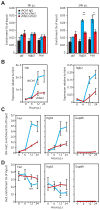Tet2 facilitates the derepression of myeloid target genes during CEBPα-induced transdifferentiation of pre-B cells
- PMID: 22981865
- PMCID: PMC3667550
- DOI: 10.1016/j.molcel.2012.08.007
Tet2 facilitates the derepression of myeloid target genes during CEBPα-induced transdifferentiation of pre-B cells
Abstract
The methylcytosine hydroxylase Tet2 has been implicated in hematopoietic differentiation and the formation of myeloid malignancies when mutated. An ideal system to study the role of Tet2 in myelopoeisis is CEBPα-induced transdifferentiation of pre-B cells into macrophages. Here we found that CEBPα binds to upstream regions of Tet2 and that the gene becomes activated. Tet2 knockdowns impaired the upregulation of macrophage markers as well as phagocytic capacity, suggesting that the enzyme is required for both early and late stage myeloid differentiation. A slightly weaker effect was seen in primary cells with a Tet2 ablation. Expression arrays of transdifferentiating cells with Tet2 knockdowns permitted the identification of a small subset of myeloid genes whose upregulation was blunted. Activation of these target genes was accompanied by rapid increases of promoter hydroxy-methylation. Our observations indicate that Tet2 helps CEBPα rapidly derepress myeloid genes during the conversion of pre-B cells into macrophages.
Copyright © 2012 Elsevier Inc. All rights reserved.
Figures






References
-
- Adolfsson J, Mansson R, Buza-Vidas N, Hultquist A, Liuba K, Jensen CT, Bryder D, Yang L, Borge OJ, Thoren LA, et al. Identification of Flt3+ lympho-myeloid stem cells lacking erythro-megakaryocytic potential a revised road map for adult blood lineage commitment. Cell. 2005;121:295–306. - PubMed
-
- Bozec A, Bakiri L, Hoebertz A, Eferl R, Schilling AF, Komnenovic V, Scheuch H, Priemel M, Stewart CL, Amling M, et al. Osteoclast size is controlled by Fra-2 through LIF/LIF-receptor signalling and hypoxia. Nature. 2008;454:221–225. - PubMed
-
- Broske AM, Vockentanz L, Kharazi S, Huska MR, Mancini E, Scheller M, Kuhl C, Enns A, Prinz M, Jaenisch R, et al. DNA methylation protects hematopoietic stem cell multipotency from myeloerythroid restriction. Nat Genet. 2009;41:1207–1215. - PubMed
-
- Bussmann LH, Schubert A, Vu Manh TP, De Andres L, Desbordes SC, Parra M, Zimmermann T, Rapino F, Rodriguez-Ubreva J, Ballestar E, et al. A robust and highly efficient immune cell reprogramming system. Cell Stem Cell. 2009;5:554–566. - PubMed
-
- Chen T, Hevi S, Gay F, Tsujimoto N, He T, Zhang B, Ueda Y, Li E. Complete inactivation of DNMT1 leads to mitotic catastrophe in human cancer cells. Nat Genet. 2007;39:391–396. - PubMed
Publication types
MeSH terms
Substances
Associated data
- Actions
Grants and funding
LinkOut - more resources
Full Text Sources
Molecular Biology Databases

